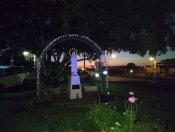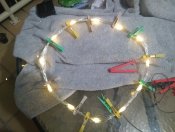This is going to be more fun added into the mix.Some of the reverse polarity ones run at 31V and work on the Hanson's DMX2-18/DC2811-2 controllers
But is 31v the highest score? Nope!
I had an Arlec branded set of rope light. Solar panel took 2 3.6v Lithium Ion batteries.
The thing outputted 70v to the string of lights. Absolutely mad.
This is the rope light seen flashing on this spiral tree:
View: https://youtu.be/Dos39scqpbw?t=16
I sent 5v directly into the solar panels circuitry. The two 3.6v batteries in series is more than 5v, but under powering it worked.
I really wanted to cut out the flashing circuitry, but getting a 70v power source was too much hassle.
In previous years I used DC buck converters to take 12v to a higher voltage, but I learnt the lesson that this is very inefficient and wastes soo much heat.



